The following aspects are important considerations for how the design for other road users can impact access and safety for pedestrians at intersections:
Corner radii of intersections in urban areas should be kept as small as possible, even if this means some vehicles need to cross the centreline to turn, as this minimises vehicle turning speeds and reduces crossing distances for pedestrians.
Kerb radii at corners that are designed to accommodate the largest possible vehicle turning at a high speed degrades the pedestrian environment and can result in longer crossing distances[1][2]. Larger radii can also mean pedestrian crossing facilities are located further from pedestrian desire lines or the pedestrian through route meets a curved kerb at a crossing point. The latter situation can make it more difficult to design kerb ramps and arrange tactile indicators to give clear and consistent messages to pedestrians.
Instead, the kerb radii at corners should be minimised as this reduces vehicle turning speeds and provides a safer and more comfortable environment for pedestrians including reduced crossing distances which take less time to cross and therefore reduce exposure for pedestrians.
It is important to select an appropriate design vehicle and a check (or control) vehicle for the street type and context. The design vehicle is the largest vehicle that frequently uses a street. This could be a standard 85th percentile car for Local Streets, or a standard bus if on a scheduled bus route. Design vehicles are expected to stay within their allotted traffic lane when making a turn. Check or control vehicles are larger vehicles that may use a street from time to time (up to a few times a week), for example, this could be a rubbish truck on Local Streets. Check vehicles should be accommodated assuming they are travelling at low speeds and allowing them to use multiple lanes, including adjacent or opposing traffic lanes depending on the movement function of the respective streets.
The first diagram below shows an intersection in a residential area with a large corner radius (11m) that allows large vehicles such as a rubbish truck (the Check vehicle) to easily turn but results in a long crossing distance of about 14m for pedestrians. The second diagram shows the same intersection but retrofitted with a smaller corner radius (4m) which significantly shortens the crossing distance for pedestrians to about 9m and requires the rubbish truck to track across the opposing traffic lane and at a slower speed which is acceptable in a residential context. In a new build urban environment the second example with the reduced kerb radii is a better outcome.
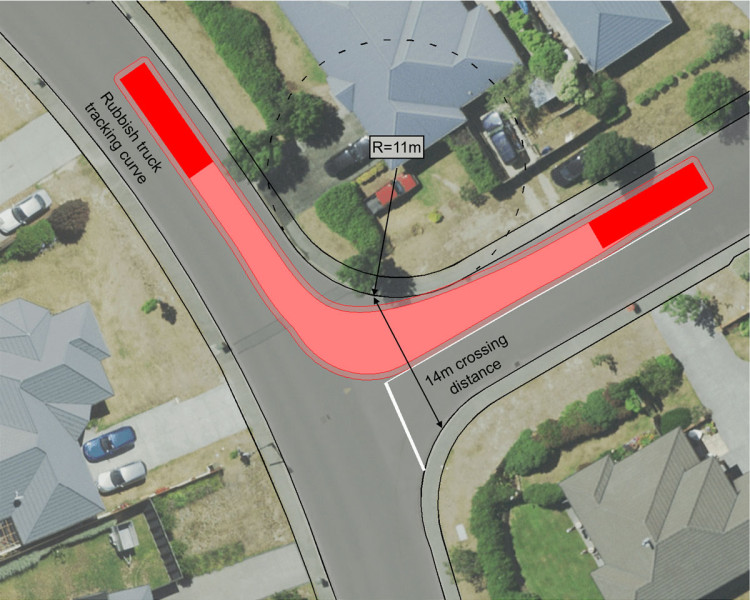
Poor practice example of a large corner radius at a residential intersection resulting in a long crossing distance for pedestrians.
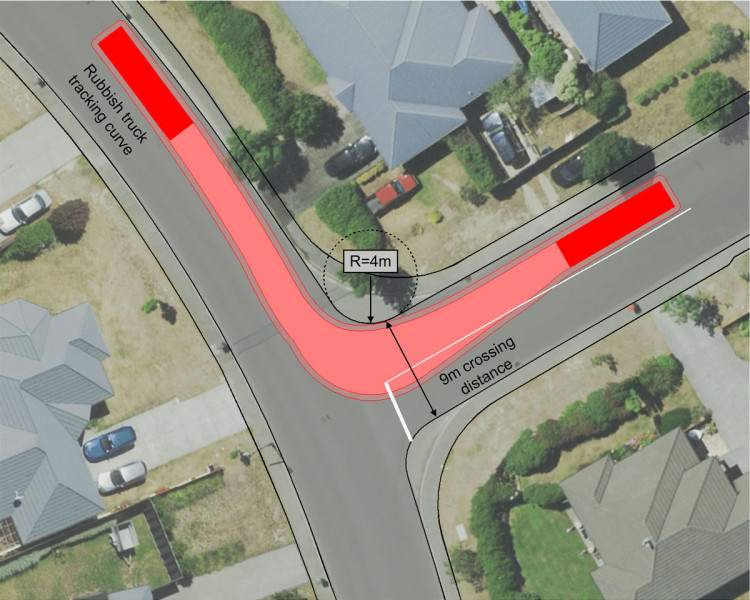
Retrofitting smaller corner radii at a residential intersection would result in a shorter crossing distance for pedestrians. Note the turning vehicle would cross into the opposing traffic lane.
The photo below shows a tight corner radius at a signalised intersection which will minimise turning vehicle speeds and allows the pedestrian crossing facilities to be located on pedestrian desire lines.
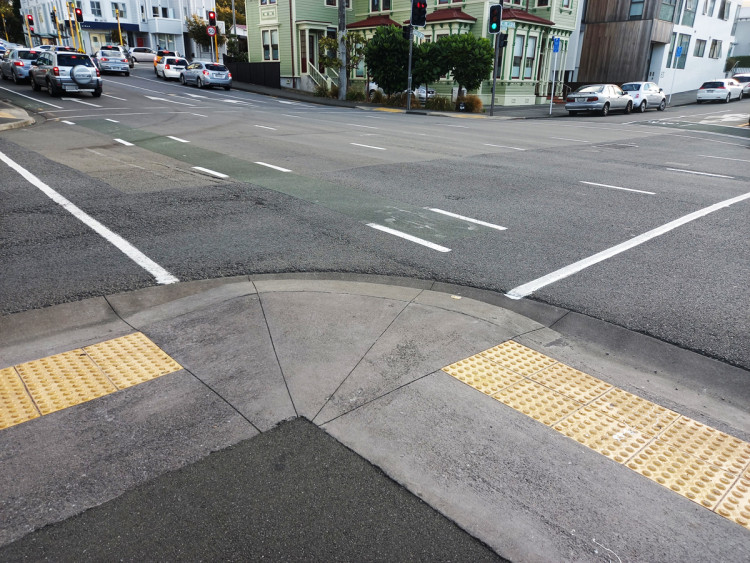
Example of tight corner radii at signalised intersection, Wellington (Photo: Jeanette Ward)
In central areas and suburban centres where pedestrian volumes are higher, the mixing of people walking and cycling should be avoided particularly at the corners of an intersection. This unnecessarily increases the potential for conflict between walking and other modes such as cycling that travel at different speeds. It also increases the potential for congestion on corners or within median islands that could lead to overspill or non-compliance by users and can make some pedestrians feel uncomfortable needing to share the footpath with higher speed modes (refer to photos below).
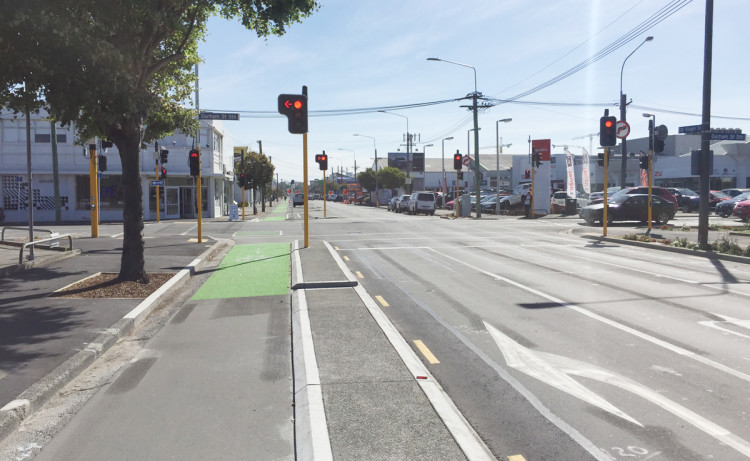
Separate spaces for users provides for more equitable allocation of space. (Photo: Gemma Dioni)
The example below shows a layout where people cycling to the crossing point have to cross over the footpath where people could be waiting or walking towards the crossing from another approach. This is less desirable particularly where pedestrian volumes are higher, for example in central city and suburban centre areas. The conflict could be removed by retaining a separated cycleway all the way to the signals.
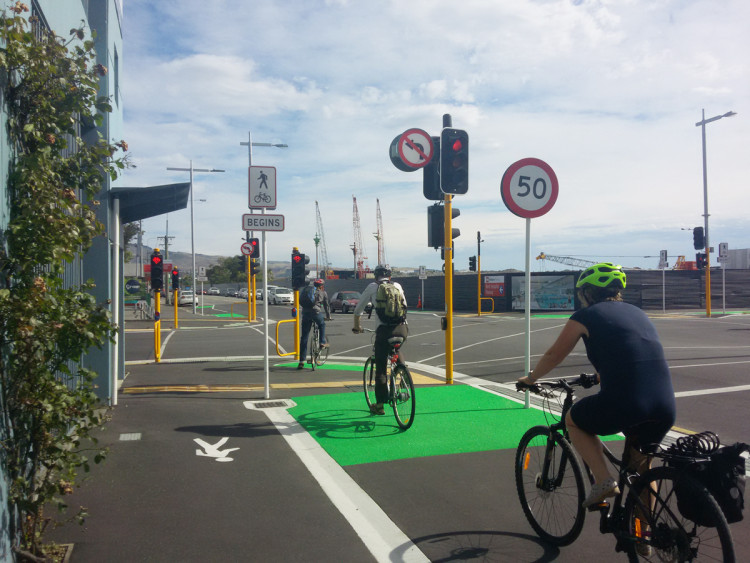
Less desirable layouts where people cycling and pedestrians mix while crossing or waiting to cross. (Photo: Megan Gregory)